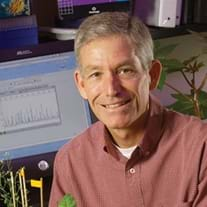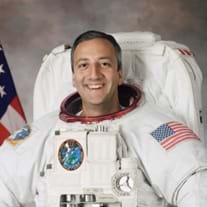Out of this World: Staying Safe and Eating Well
NASA and research teams around the world are strategizing to meet the needs of astronauts who will embark on deep space explorations beyond the moon.
Published October 1, 2019
By Hallie Kapner
Academy Contributor
A packet of periwinkle seeds is being prepped for a ride into orbit, tucked into a pouch on a SpaceX rocket bound for the International Space Station (ISS).
The seeds won’t be grown on board — at least not yet. Rather, they’re one part of a broad research effort to probe the ancient botanical pathways that yield some of today’s most widely used medications — including analgesics, antimalarials and powerful chemotherapeutic agents — and to learn what secrets common plants have yet to reveal.

Joseph Chappell, keeper of the periwinkles and chair of the department of pharmaceutical sciences at the University of Kentucky, hatched what he and his collaborators at Space Tango, a Lexington-based startup, admit was a far-fetched plan when they hypothesized that the microgravity environment of space could unlock previously unknown therapeutic pathways in plants.
Much the way that a yearlong stint aboard the ISS altered astronaut Scott Kelly’s patterns of gene expression, Chappell wondered whether the unique stress of microgravity might trigger epigenetic changes in plants that produce medicinal molecules. Uncovering new compounds could be a boon to commercial drug development, but the payoff could be at least a decade and a billion dollars away. Chappell and his collaborators have more immediate goals in mind.
A Source for Food and Medicine
“If we want to support astronauts on Mars missions or other deep space explorations, we have to provide food, fiber and medicine,” Chappell explained, referencing a trifecta of essential needs that NASA and research teams around the world are strategizing to meet as they plan for manned missions beyond the moon.
A round trip to the red planet is chief among their goals, a voyage that would propel one courageous crew farther than humans have ever traveled. A trip to Mars is expected to last at least three years, amid conditions and stresses unimaginable on Earth.
Beyond developing new drugs for terrestrial use, Chappell and his team are studying the potential for stints in space to evoke beneficial epigenetic changes in plants that he claims “offer the whole suite — sources of nutrition, sources of fiber for clothing and other materials, and sources of drugs” — plants that astronaut crews could both grow and utilize on long-term space missions. One plant that piques his interest is hemp, the utilitarian varietal of Cannabis sativa, which has a 10,000-year history as a fiber for rope and fabrics, and a more recent reputation as a source of protein-rich seeds and oil rife with non-intoxicating cannabinoids used to treat maladies ranging from inflammation and insomnia to epileptic seizures.
No Small Feat
The demands placed on the first Mars crew will surpass those of any astronauts in history. Far beyond the traditional roles of pilot, commander, flight engineer or payload specialist, the crew will need to be gardeners, diagnosticians, health care providers and perhaps even settlers, as some projections for a Mars voyage involve the temporary establishment of the first human accommodations on another planet.
Crews will struggle with isolation and confinement, as well as the psychological toll of being separated from family, friends and gravity for years at a stretch. In circumstances where maintaining health, strength and well-being are critical, crews will be reliant on freeze-dried or thermostabilized meals as their primary nutrition source. With no possibility of resupply missions from NASA, a case of menu fatigue will be riskier than ever. Medical care will be millions of miles away, and even a consultation with a flight surgeon will become increasingly impractical as the crew ventures farther into space: a single round trip radio transmission from Mars to Earth takes 40 minutes.
How to keep deep space astronauts healthy, sane, comfortable and collaborative are concerns that require at least as much attention as the technological and engineering developments required to mount a mission to Mars. Balancing the research needs of the mission and the human needs of the crew is no small feat. Accounting for these needs for several years in a profoundly resource-constrained environment requires galactic-scale ingenuity from a team of fiercely optimistic scientists, engineers and entrepreneurs from around the world.
“This is What I Want to Eat”


Chappell’s vision of growing multi-purpose plants in space is far from sci-fi, although zero-gravity farming is still in its infancy. ISS astronauts have already grown several varieties of lettuce and other leafy greens, thanks to an onboard plant growth chamber aptly named Veggie. While some space-grown greens have been eaten in orbit, crews rely heavily on pouched meals meticulously designed by the Space Food Systems group at NASA’s Johnson Space Center.
What space cuisine lacks in presentation it makes up for in ease of preparation and nutrition — in less than 30 minutes, astronauts can reconstitute a meal with (recycled) water, heat it and dine directly from the package. Astronaut fare is created to deliver essential nutrients and calories through meals that may look unusual, but often taste good and, equally important, are familiar and appealing to crews.
Advancing Food Technology
“For a Mars mission, the menu needs to be something that people are content to eat for a long time, and that’s a big challenge,” said Grace Douglas, advanced food technology lead scientist at NASA and leader of a group working to devise a food system for deep space exploration. “If the food isn’t highly acceptable — if crews don’t look at the options and say, ‘this is what I want to eat’ — then they’ll eat enough to get by, but not enough to maintain weight, which can compromise bone and muscle mass and even immune health,” she explained.
In space, as on Earth, food is more than simply fuel, and our associations with what we eat are both emotional and physical. Far from home, we often miss the familiarity of both food and family, craving the meal itself as much as the companionship. Such evocations make Douglas’ job both more difficult and more important. Among all the comforts long-haul astronauts will forego, Douglas believes some comfort from food should remain.
The Perfect Package
Oxygen, temperature, time, moisture: meet the enemies of nutrient-rich food that tastes great for up to five years.
“None of the food we send up now has that kind of shelf-life in terms of stable nutrition and quality,” Douglas said, noting that the stated shelf life for current astronaut food is 18–24 months.
For Mars, five years is the magic number. Weight and space are precious, expensive commodities on a spacecraft, and some food provisions will likely travel in advance of the crew. Those rations need to be safe, appealing, and nutritious from the moment of liftoff until crews consume them on Mars as well as the flight home. This necessitates an ambitious evolution of the space food system and the development of new technologies to sterilize and store meals without compromising appeal, essential nutrients, or adding excess waste or preparation time.
NASA currently packages meals in the same pouches used for military rations, foil-lined sacks that Douglas claims are “the best thing out there” for meeting the strict weight and barrier requirements of space packaging. Yet even the best option can’t touch the five-year mark, as the methods used to sterilize and stabilize meals can jumpstart the processes by which nutrition and quality degrade over time.
New technologies, such as microwave-assisted thermal sterilization, may help extend the life of Mars-bound meals, but will also require the development of a next-generation pouch compatible with such methods. Douglas explained that NASA is also exploring how different environmental conditions — including deep freezing — may be used to preserve nutrients and quality for longer than the current limits.
Ohmic Heating

Here on Earth, food scientists like Sudhir Sastry, professor of food, agricultural, and biological engineering at Ohio State University, are pioneering techniques for killing pathogenic microbes without compromising nutrition or quality. One such method, ohmic heating, may have some utility for long-haul space travel.
Rather than relying on steam and pressure, ohmic heating uses electrical fields to sterilize or reheat packaged food evenly in seconds, rendering it safe for consumption while retaining many essential nutrients. According to Sastry, about 90 percent of even the most heat labile nutrients, such as vitamin C, remain after sterilization. Dr. Megan Bourassa, a biochemist and an expert in nutrition science at the New York Academy of Sciences, believes finding a way to retain nutrients is crucial.
“Stability and shelf-life of nutrients are definitely huge issues on Earth, especially in fortified foods,” said Bourassa. “For a five-year journey, food would probably have to be over-fortified to account for degradation over time and loss after cooking.”
Greening the Red Planet
Moviegoers will remember Matt Damon’s character in the film The Martian cleverly repurposing human waste as fertilizer to grow potatoes in a makeshift greenhouse on Mars. Douglas confirms that while Damon’s character didn’t have the resources to build such a robust growing operation, Mars travelers will likely have the ability to grow and consume leafy green vegetables during their voyage.
“As we move further from Earth, we are going to need to have systems of growing food,” Douglas said, although the notion of a Martian-style greenhouse remains quite futuristic.
Research teams have simulated the environmental conditions on Mars to determine how crops might someday be grown there — likely hydroponically — safe from the planet’s freezing temperatures, carbon dioxide-rich atmosphere and high levels of galactic cosmic radiation. University of Kentucky’s Joseph Chappell noted that plants grown in deep space as well as in the Martian atmosphere may undergo gene expression changes or mutations that either boost or degrade the nutritional profile of edible plants — another area of research that must be explored before crews could safely rely on Mars-grown food as a source of calories and nutrients.
“To be reliant on a system like that you’d need a surplus to ensure that if you had a loss of crop, it didn’t mean a loss of crew,” Douglas added.
The Issue of Water
Then there is the issue of water. Despite the recent discovery of what appears to be a 12-mile-wide body of water buried under a mile-thick layer of polar ice, there is no known source of fresh water on Mars. Any liquid water found on the planet is likely to contain toxic levels of perchlorates and other chemicals.
If terraforming Mars is to become a reality, settlers will need a source of fresh water for drinking, preparing food and for agricultural purposes. The carbon dioxide that comprises 95 percent of the Martian atmosphere has been eyed as a feedstock for reactions that could produce a steady supply of water for use on the planet, although technologies capable of performing those reactions at scale have yet to be realized.
The Body Weightless
Two hours a day at the gym would qualify anyone as an exercise nut on Earth, but in space, it’s the norm. Without gravity providing resistance for muscles and bones, both can weaken over time.
Today’s ISS astronauts toggle between several different pieces of exercise equipment, all designed to counter the effects of microgravity and minimize bone loss. Mars-bound crews will have a smaller spacecraft, and a new generation of compact exercise devices is already being developed for deep space flights. Despite their workout regimen, today’s ISS crews universally experience muscle weakness upon returning to Earth.
In his book, Endurance, Scott Kelly described the physical sensation of “all my joints and all my muscles protesting the crushing pressure of gravity” after a full year of weightlessness. Mars astronauts will clock at least three times more time in zero or reduced-gravity than Kelly did, making the return to Earth more difficult and highlighting the importance of maintaining muscle strength and cardiovascular stamina on long missions.
Despite the experiences of more than 250 ISS astronauts and more than 350 shuttle astronauts, there is still much to learn about the specific effects of microgravity on the body and its tissues over long periods of time. To accelerate the process, the U.S. Center for the Advancement of Science in Space has partnered with researchers around the world to send human tissue samples into orbit, growing three-dimensional cultures that allow scientists to study the direct effects of microgravity on various organs.
Changes in Gene Expression
Spaceflight is known to induce changes in gene expression, and may also alter the progression of diseases including cancer and cardiovascular disease. Insights derived from organoids in microgravity today may lead to protective mechanisms for tomorrow’s astronauts, and could yield new therapeutics for use on Earth.
Similar research using cell cultures tests the impact of yet another deep space concern on the human body: galactic cosmic radiation. Earth is constantly bombarded by solar radiation and cosmic radiation from within the Milky Way, yet everything on the planet is doubly shielded — first by a geomagnetic field that deflects dangerous rays and particles, then by Earth’s thick atmosphere.
Those who venture beyond the bubble lose these protections. Mitigating the risks of radiation damage is a major challenge for Mars mission planners.
Researchers at the NASA Space Radiation Laboratory at Brookhaven National Laboratory are simulating cosmic radiation by blasting biological samples with ions that mimic the rays Mars travelers will encounter in space. Plans both practical and seemingly outlandish abound for combating space radiation, from a protective vest currently used to protect soldiers and first responders from radiation threats, to an artificial magnetic shield that would restore Mars’ own magnetosphere, lost to solar wind erosion billions of years ago. Solving the radiation problem will require a combination of advances in materials science, physical shielding measures for craft and crew, and potentially even pharmaceuticals that could reduce gene mutations resulting from radiation exposure or accelerate the restoration of radiation depleted cell populations.
It’s Lonely Out in Space
Rocket Man, Elton John’s 1972 anthem of the homesick space traveler, presciently articulated the concerns of many researchers working to realize the dream of a trip beyond our planet.
Humans have long braved extreme isolation and remote environments in the name of discovery, but never without gravity, fresh air, sunrise and sunset. Add loneliness, confinement, boredom, separation from loved ones and a healthy mix of fear and anticipation, and the potential for psychological difficulties among deep space astronauts ranks highly.

Nobody has spent more consecutive days in space than Russian cosmonaut Valery Polyakov, who logged a remarkable 438 days on the Mir space station in the 1990s. A Mars mission will last far longer.
In order to better understand the limits of loneliness and the triggers of distress, and to identify factors that promote resilience in tough conditions, teams of researchers in Hawaii, Moscow and Antarctica have studied groups of fellow scientists living in conditions similar to those of a future Mars mission. Complete with field work analogous to the tasks astronauts would need to complete on Mars, time-delayed communication with mission control, pre-packaged and freeze-dried foods, close quarters, and irregular sleep and wake cycles, these simulations have provided valuable insights into human behavior and helped hone in on personality traits that may be desirable in a Mars crew.
‘Til Touchdown Brings Me ‘Round Again
Identifying activities and amenities that boost astronaut morale are also high priorities. Among the wellness-enhancing pursuits that may be reasonably accessible on a Mars mission, tending to green plants ranks high, as does exercise. Virtual reality technologies are also being tested as a method to reconnect astronauts to the sights and sounds of Earth — be it waves crashing on a beach, the green grass of the countryside, or birds soaring over the glass-like surface of a lake.
After completing a series of missions that serve as critical stepping stones to deep space flight, NASA plans to launch a manned mission to Mars in the 2030s. The scientific community’s tireless efforts to realize the day when a human will set foot on Mars throws into stark relief the intricate, perfectly-tuned biological machinery that allows us to thrive effortlessly here, on our blue planet.
As we prepare to travel farther than ever before, it is impossible not to appreciate how well-suited we are to life at home. Upon his final voyage to repair the Hubble Space Telescope in 2009, shuttle astronaut Mike Massimino, awed at the beauty of the Earth, said it best.
“This is what heaven must look like,” he said. “I think of our planet as a paradise. We are very lucky to be here.”
